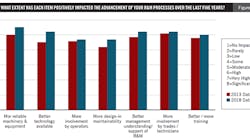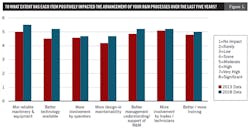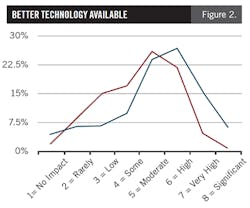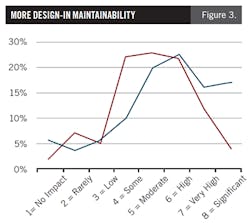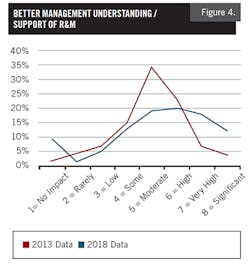Perspective: PdM research shows positive gains in reliability and maintainability
In a 2008 survey I conducted, I asked participants to envision the major changes needed in reliability and maintainability (R&M) in the next 10 years. Respondents indicated that “people and cultural improvements” and “more design-in R&M” would be required to meet their vision and attain their goals pertaining to R&M over the next decade. Participants also ranked “better management understanding of R&M” and “more-reliable machinery and equipment” as likely to have the most potential positive impact on reliability (at that time). Large opportunities for further improvements were noted as possible if more operator involvement could be attained.
In 2013, I repeated the study and asked participants to consider the results of their efforts. Then last year, Plant Services included the question in its 2018 Predictive Maintenance/Prescriptive Maintenance (PdM/RxM) survey. The reflective, results-focused question is, “To what extent has each item positively impacted the advancement of your reliability and maintainability processes over the last five years?”
Figure 1 shows the 2013-vs.-2018 comparison of the seven categories. Note that there is consistent improvement in all areas. The largest gain (positive impact on R&M) in the past five years was in “better technology available.” The next-highest gain was a tie between “more-reliable machinery & equipment” and “more designed-in maintainability.” Viewing each response category separately shows that each of the positive impacts is making more of a difference. This reinforces the trend that many of the factors that support R&M, although not all best practices, are trending in the right direction.
Having more-reliable machinery & equipment results from a commitment to conducting root-cause analyses (RCA) and implementing improvements. As the data indicate, some companies are working to instill and sustain RCA as part of their maintenance culture. However, most still do not have a robust RCA process in place. The norm is more of an informal process with insufficient corrective measures implemented and rarely followed up on to ensure the sustainability of a solution.
Better technology available (see Figure 2) will be a game-changer in the near future. All of the predictive technologies (such as vibration, infrared, ultrasound, etc.) have already made enormous strides in helping plants achieve reliability gains. The interconnectivity of devices and the fact that today’s predictive tools are more user-friendly and less costly provides great opportunity for plant-floor practicable applications. Machine learning, augmented reality, virtual reality, and other algorithm-based offerings will become common tools. Companies that can’t collect good data – data that can be trusted enough to inform operational decisions – will continue to struggle.
More involvement by operators has been and still is a tough challenge for most companies. However, data indicates that even getting the operator involved in checking and responding to visual controls is worthwhile.
More design-in maintainability (see Figure 3) is difficult to accomplish without an active RCA process in place and without having reliability and maintenance expectations built into your company’s purchase specifications. Decisions should be made based on the life-cycle cost of machinery and equipment. Keep in mind that maintainability is a designed-in parameter (with modularity, standardization, accessibility, diagnostics, ease of disassembly, and many more considerations factoring in).
Better management understanding/support of R&M (see Figure 4) is making progress. I am seeing more upper managers involved in discussions and training and starting to ask R&M questions. Those who understand the benefits to ROI and all parts of the business are supportive. Some aren’t patient enough to implement the needed supporting processes.
More involvement by trades/technicians also has improved. This gets back to having a robust continuous improvement process. Enabling a partnership between operations and maintenance has been a foundational element of almost every top-performing facility. That means having common goals and/or absolutes (statements of best daily practices) that both parties honor and hold each other accountable for.
Dr. Klaus Blache is research professor of industrial and systems engineering and director of the Reliability and Maintainability Center at the University of Tennessee College of Engineering in Knoxville. He is a past chairman of SMRP and past manager of manufacturing reliability and maintenance at General Motors. Contact him at [email protected].
Better/more training is trending positive, as well. Here, the focus should be on getting the right kind of training for what your end goal is. In addition, have a plan to put the training to use immediately to help ingrain the learned knowledge and practices.
It was good to see all of the responses moving in a forward direction. Most places I’ve visited or assessed in the past year were resource-constrained (more things to do than people to do them). Some of those issues could be resolved by applying R&M best practices. In other cases, the facilities were just short-handed. People figure out what practices allow them to survive, and when those less-than-optimal practices are carried out over a long period of time, they become the accepted way.
Progress can be made in smaller efforts by almost anyone with enough tenacity, fortitude, and vision. Sometimes enough small successful efforts evolve into a better R&M process. At the end of the day, however, it’s going to take leadership commitment and support to attain and sustain R&M top-quartile performance.
